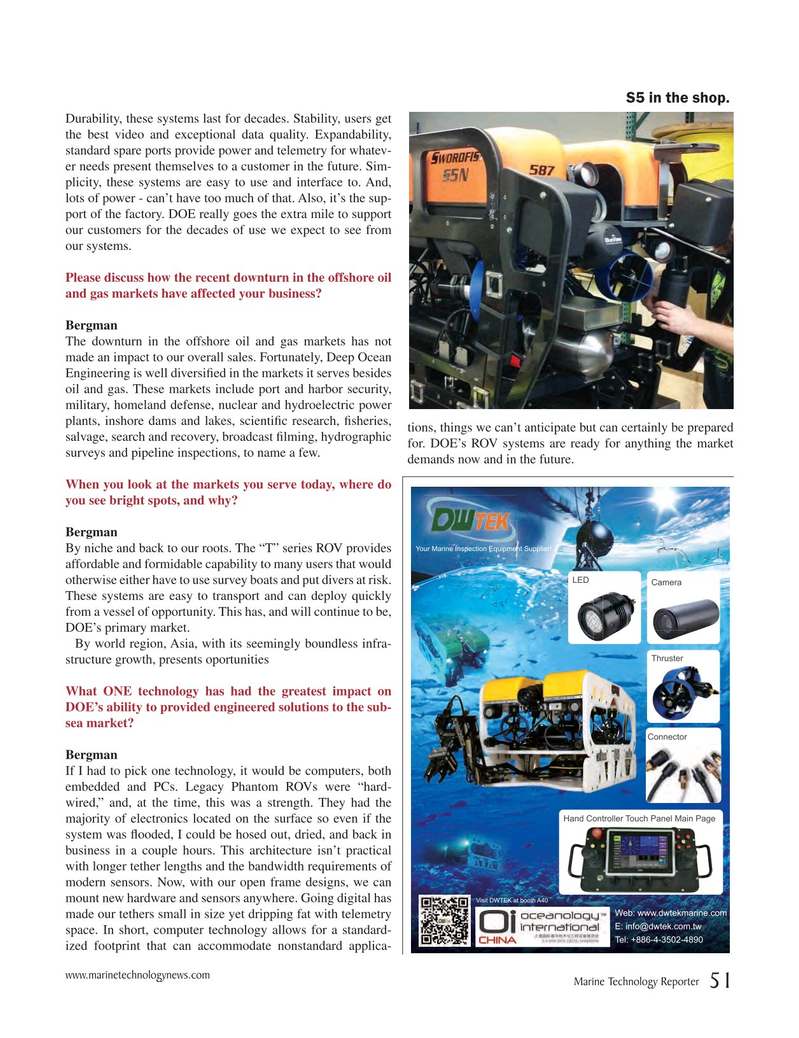
Page 51: of Marine Technology Magazine (October 2015)
AUV Operations
Read this page in Pdf, Flash or Html5 edition of October 2015 Marine Technology Magazine
S5 in the shop.
Durability, these systems last for decades. Stability, users get the best video and exceptional data quality. Expandability, standard spare ports provide power and telemetry for whatev- er needs present themselves to a customer in the future. Sim- plicity, these systems are easy to use and interface to. And, lots of power - can’t have too much of that. Also, it’s the sup- port of the factory. DOE really goes the extra mile to support our customers for the decades of use we expect to see from our systems.
Please discuss how the recent downturn in the offshore oil and gas markets have affected your business?
Bergman
The downturn in the offshore oil and gas markets has not made an impact to our overall sales. Fortunately, Deep Ocean
Engineering is well diversi? ed in the markets it serves besides oil and gas. These markets include port and harbor security, military, homeland defense, nuclear and hydroelectric power plants, inshore dams and lakes, scienti? c research, ? sheries, tions, things we can’t anticipate but can certainly be prepared salvage, search and recovery, broadcast ? lming, hydrographic for. DOE’s ROV systems are ready for anything the market surveys and pipeline inspections, to name a few.
demands now and in the future.
When you look at the markets you serve today, where do you see bright spots, and why?
Bergman
By niche and back to our roots. The “T” series ROV provides affordable and formidable capability to many users that would otherwise either have to use survey boats and put divers at risk.
These systems are easy to transport and can deploy quickly from a vessel of opportunity. This has, and will continue to be,
DOE’s primary market.
By world region, Asia, with its seemingly boundless infra- structure growth, presents oportunities
What ONE technology has had the greatest impact on
DOE’s ability to provided engineered solutions to the sub- sea market?
Bergman
If I had to pick one technology, it would be computers, both embedded and PCs. Legacy Phantom ROVs were “hard- wired,” and, at the time, this was a strength. They had the majority of electronics located on the surface so even if the system was ? ooded, I could be hosed out, dried, and back in business in a couple hours. This architecture isn’t practical with longer tether lengths and the bandwidth requirements of modern sensors. Now, with our open frame designs, we can mount new hardware and sensors anywhere. Going digital has made our tethers small in size yet dripping fat with telemetry space. In short, computer technology allows for a standard- ized footprint that can accommodate nonstandard applica- www.marinetechnologynews.com
Marine Technology Reporter 51
MTR #8 (50-64).indd 51 9/30/2015 2:55:40 PM

 50
50

 52
52
